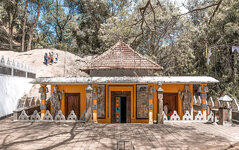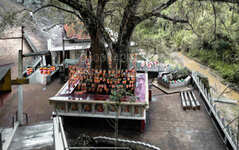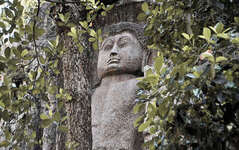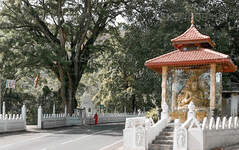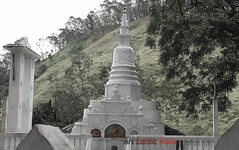
Bandarawela City
Escape to the scenic highlands of Bandarawela, where our welcoming retreat invites you to experience serenity and adventure. Enjoy breathtaking views, explore tea estates, and immerse yourself in the rich culture of this charming hill town. Your idyllic retreat in Bandarawela awaits
Dowa Raja Maha Viharaya
Dowa Raja Maha Viharaya (also known as Dowa Cape Temple) lies few kilometres away from the Bandarawela town on the Bandarawela – Badulla Road. This temple is thought to be done by King Walagamba in the in first century BC. This is one of the many temples built by the king while taking refuge in the Uva Province after an Indian invasion.
The temple has gain popularity mainly due to its massive 38 feet Buddha Statue carved in the granite rock. But this temple also hides some secrets that time has forgotten.
The uncompleted image of the Buddha is carved out of a granite boulder which is well hidden form the main road. No much of attention has been given to this statue and it seems to be slowly breaking up. At the top pf the boulder is a small stupa. This stupa is the on the same level as the road and it is the only indication of a temple to a traveler on the road.
At the rear of the image house is a small stupa inside a cave. Behind this stupa, inside the cave is a tunnel called the Ravana Guhawa guarded by a figure of a Clay King Cobra. This 11 km long tunnel is said to be connecting the Ravana Maha Viharaya at Ella and the Bogoda Raja Maha Viharaya. But unfortunately this tunnel entrance has been sealed off with cement by the temple due to various vandalism acts by treasure hunters. It said that the king disappeared from the area overnight using the the tunnels and thus the working on the Buddha Statue was abruptly stopped.
The Image house built inside the cave is full of colourful murals and Buddha Images and consist of 3 chambers. On the sides of the main entrance to the image house is two guardians, one with a elephant in its mouth and the other with a bull (?) in its mouth. It is said to be they are Watuka and Kuvera, two Rakshasa tribal leaders, guarding the entrance to the shrine room. The door frame of the Image House in the temple is made out of solid rock and has a inscription to say it was built in 1880. The outer most chamber is filled with murals from the Kandyan Era. Entrance to the second chamber is decorated with a elaborated Makara Thorana . In the second chamber is a row of Buddha images along with paintings. The rock canopy is decorated with various motifs. Hidden in these decorations is a rare painting of “Eth – Gon Satana” ( a elephant – bull fight )
Entrance to the 3rd chamber is a simple wooden door and inside is two reclining statues of Buddha along the contours of the cave.
The Bo Tree is on a higher elevation than the image house. On this platform is a small pond surrounding a rock. This rock forms a natural water sprout and water continuously flow through small openings at the the top of the rock.
About Badulla District
Badulla is the capital of Uva Province in Sri Lanka. Badulla is located on the southeast of Kandy, almost encircled by the Badulu Oya River, about 680 meters (2200 ft) above sea level and is surrounded by tea plantations. The town is overshadowed by the Namunukula range of mountains. Badulla is about 230km away from Colombo towards the eastern slopes of central hills of Sri Lanka.
Badulla and surroundings are highly recommended for eco-tourists as Horton Plains National Park and the Knuckles mountains are few hours away.
Special places in Badulla: Muthiyangana temple, Dhowa temple, Bogoda ancient wooden bridge, Rawana water falls
About Uva Province
The Uva Province is Sri Lanka's second least populated province, with 1,187,335 people, created in 1896. It consists of two districts called Badulla and Monaragala The provincial capital is Badulla. Uva is bordered by Eastern, Southern and Central provinces. Its major tourist attractions are Dunhinda Falls, Diyaluma Falls, Rawana Falls, the Yala National Park (lying partly in the Southern and Eastern Provinces) and Gal Oya National Park (lying partly in the Eastern Province). The Gal Oya hills and the Central Mountains are the main uplands, while the Mahaweli and Menik rivers and the huge Senanayake Samudraya and Maduru Oya Reservoirs are the major waterways in Uva province.

